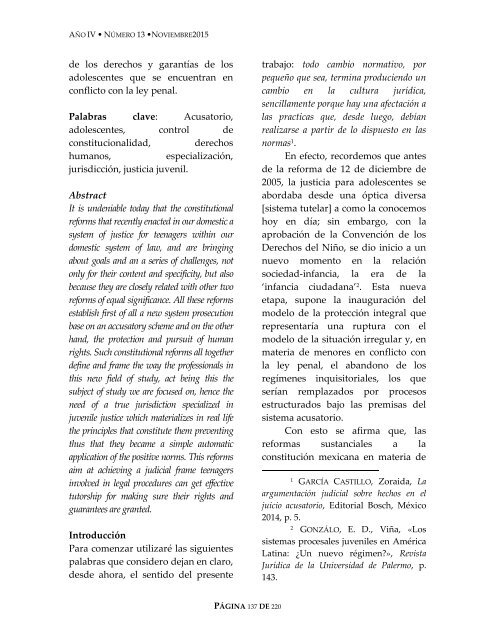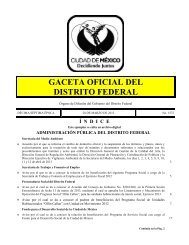Create successful ePaper yourself
Turn your PDF publications into a flip-book with our unique Google optimized e-Paper software.
AÑO IV • NÚMERO 13 •NOVIEMBRE2015<br />
de los derechos y garantías de los<br />
adolescentes que se encuentran en<br />
conflicto con la ley penal.<br />
Palabras clave: Acusatorio,<br />
adolescentes, control de<br />
constitucionalidad, derechos<br />
humanos,<br />
especialización,<br />
jurisdicción, justicia juvenil.<br />
Abstract<br />
It is undeniable today that the constitutional<br />
reforms that recently enacted in our domestic a<br />
system of justice for teenagers within our<br />
domestic system of law, and are bringing<br />
about goals and an a series of challenges, not<br />
only for their content and specificity, but also<br />
because they are closely related with other two<br />
reforms of equal significance. All these reforms<br />
establish first of all a new system prosecution<br />
base on an accusatory scheme and on the other<br />
hand, the protection and pursuit of human<br />
rights. Such constitutional reforms all together<br />
define and frame the way the professionals in<br />
this new field of study, act being this the<br />
subject of study we are focused on, hence the<br />
need of a true jurisdiction specialized in<br />
juvenile justice which materializes in real life<br />
the principles that constitute them preventing<br />
thus that they became a simple automatic<br />
application of the positive norms. This reforms<br />
aim at achieving a judicial frame teenagers<br />
involved in legal procedures can get effective<br />
tutorship for making sure their rights and<br />
guarantees are granted.<br />
Introducción<br />
Para comenzar utilizaré las siguientes<br />
palabras que considero dejan en claro,<br />
desde ahora, el sentido del presente<br />
trabajo: todo cambio normativo, por<br />
pequeño que sea, termina produciendo un<br />
cambio en la cultura jurídica,<br />
sencillamente porque hay una afectación a<br />
las practicas que, desde luego, debían<br />
realizarse a partir de lo dispuesto en las<br />
normas 1 .<br />
En efecto, recordemos que antes<br />
de la reforma de 12 de diciembre de<br />
2005, la justicia para adolescentes se<br />
abordaba desde una óptica diversa<br />
[sistema tutelar] a como la conocemos<br />
hoy en día; sin embargo, con la<br />
aprobación de la Convención de los<br />
Derechos del Niño, se dio inicio a un<br />
nuevo momento en la relación<br />
sociedad-infancia, la era de la<br />
‘infancia ciudadana’ 2 . Esta nueva<br />
etapa, supone la inauguración del<br />
modelo de la protección integral que<br />
representaría una ruptura con el<br />
modelo de la situación irregular y, en<br />
materia de menores en conflicto con<br />
la ley penal, el abandono de los<br />
regímenes inquisitoriales, los que<br />
serían remplazados por procesos<br />
estructurados bajo las premisas del<br />
sistema acusatorio.<br />
Con esto se afirma que, las<br />
reformas sustanciales a la<br />
constitución mexicana en materia de<br />
1<br />
GARCÍA CASTILLO, Zoraida, La<br />
argumentación judicial sobre hechos en el<br />
juicio acusatorio, Editorial Bosch, México<br />
2014, p. 5.<br />
2<br />
GONZÁLO, E. D., Viña, «Los<br />
sistemas procesales juveniles en América<br />
Latina: ¿Un nuevo régimen?», Revista<br />
Jurídica de la Universidad de Palermo, p.<br />
143.<br />
PÁGINA 137 DE 220




